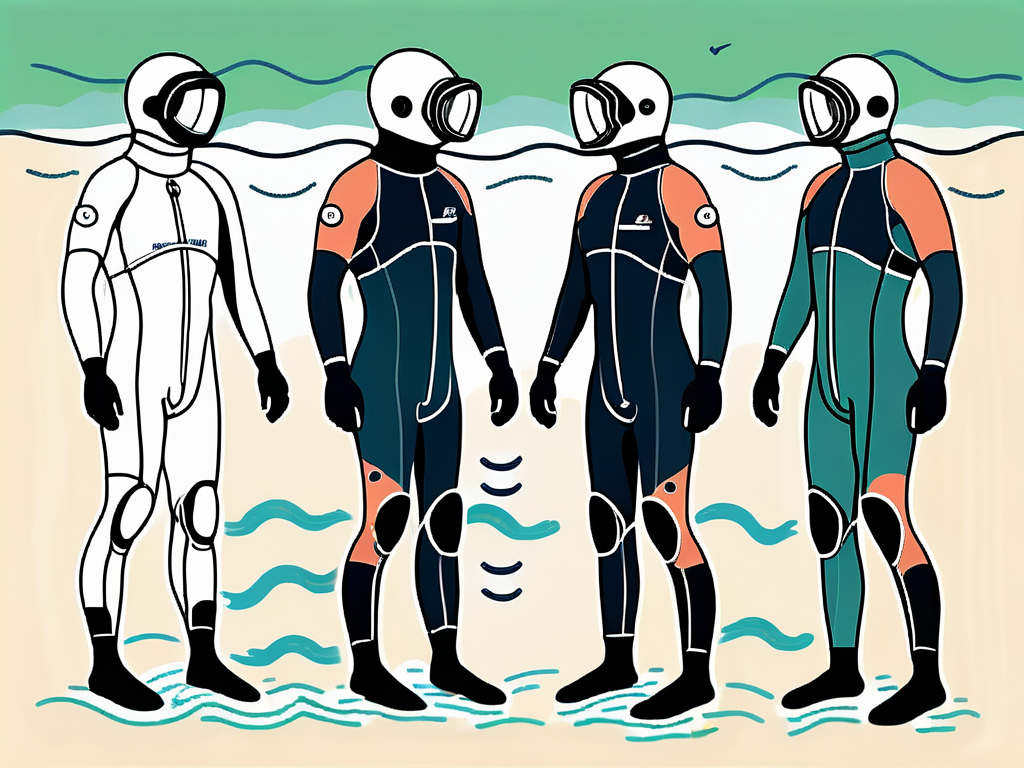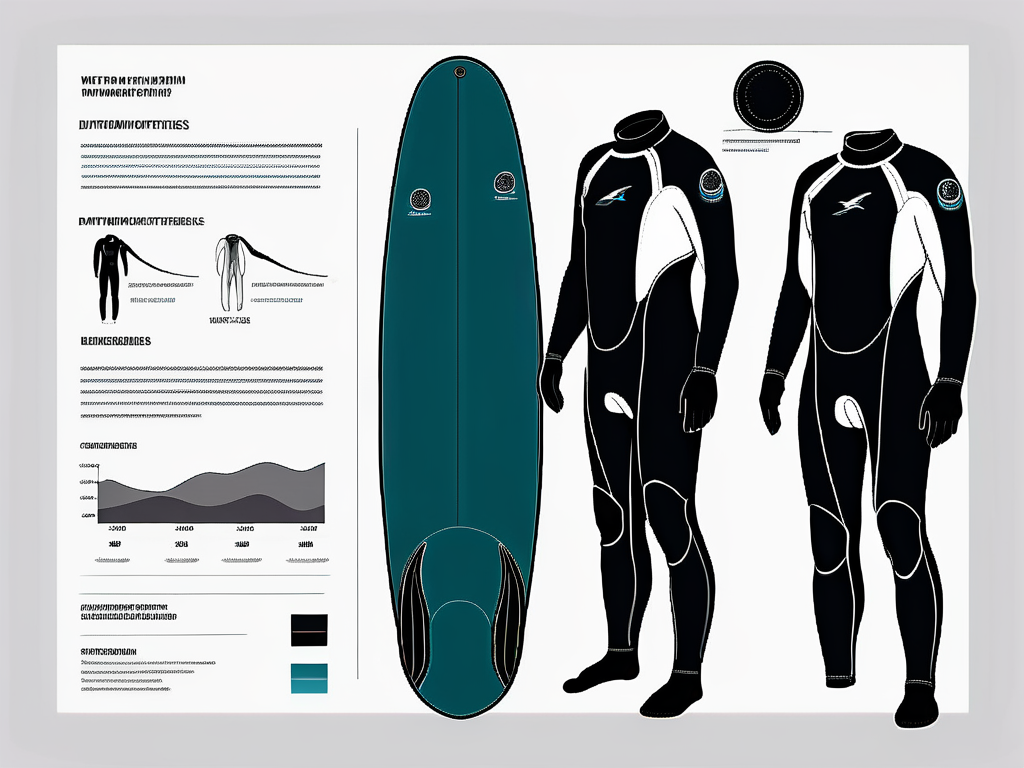The Ultimate Guide to Choosing the Right Wetsuit Thickness for Diving
Are you a diving enthusiast looking to explore the underwater world? Or maybe you're a seasoned diver ready to take your experiences to the next level? Whatever the case may be, one essential piece of equipment you need to consider is a wetsuit. In this ultimate guide, we will dive deep into the world of wetsuit thickness and explore how it affects your diving experience.
Exploring the Feasibility of Diving in a Wetsuit
Before we delve into the specifics of wetsuit thickness, let's first understand the importance of wearing a wetsuit while diving. A wetsuit not only provides thermal insulation but also protects your skin from potential scrapes and stings.
While it is possible to dive without a wetsuit, the benefits of wearing one outweigh the comfort of swimming in just a swimsuit. With a wide range of wetsuit thicknesses available, there is a perfect fit for every dive.
When considering the thickness of a wetsuit for diving, it's essential to take into account the water temperature of the dive location. Warmer waters typically require thinner wetsuits, while colder waters necessitate thicker ones for better insulation. The thickness of a wetsuit is measured in millimeters, with options ranging from 1mm to 7mm or more, depending on the diving conditions.
Another factor to consider when choosing a wetsuit is the material it's made from. Neoprene is the most common material used for wetsuits due to its insulating properties and flexibility. High-quality neoprene wetsuits provide both warmth and mobility, allowing divers to move comfortably underwater.
The Ins and Outs of Scuba Diving Sans Wetsuit
For some divers, the idea of diving without a wetsuit may seem appealing. However, it's essential to understand the potential risks involved in diving without proper insulation.

Without a wetsuit, your body is exposed to the elements, which can lead to rapid heat loss and increase the risk of hypothermia, especially in colder waters. Additionally, without the protection of a wetsuit, your skin is vulnerable to potential cuts, abrasions, and stings from marine life.
Furthermore, diving without a wetsuit can also impact your buoyancy control. Wetsuits not only provide thermal protection but also help with buoyancy by trapping a thin layer of water between the suit and your skin. This added buoyancy can make it easier to achieve and maintain neutral buoyancy underwater, allowing you to conserve energy and air more efficiently.
Another consideration when diving without a wetsuit is the increased risk of sunburn. The sun's UV rays can be especially intense on the water's surface, and without the coverage of a wetsuit, your skin is more susceptible to sun damage. Applying a high SPF sunscreen before the dive and wearing a rash guard or other protective clothing can help mitigate this risk.
Choosing the Right Wetsuit Thickness for Your Dive
Now that we understand the importance of wearing a wetsuit while diving, let's dive into the factors to consider when selecting the appropriate wetsuit thickness for your dive.
When it comes to diving, one of the most critical decisions you'll make is choosing the right wetsuit thickness. A wetsuit not only keeps you warm but also protects you from abrasions and stings. Understanding the factors that influence wetsuit thickness can make a significant difference in your diving experience.
Factors to Consider When Selecting Diving Wetsuit Thickness
1. Water temperature: The water temperature plays a crucial role in determining the wetsuit thickness you should choose. Colder waters require thicker wetsuits to provide adequate insulation. For example, in frigid waters, a 7mm wetsuit might be necessary to keep your body temperature regulated.
2. Dive duration: If you plan to embark on long dives, a thicker wetsuit will provide better insulation, ensuring your body stays warm throughout the dive. Extended exposure to water can lead to hypothermia if you are not properly insulated, making the thickness of your wetsuit a critical factor to consider.
3. Depth of dive: The depth of your dive can also influence the wetsuit thickness required. Deeper dives may expose you to cooler temperatures, necessitating a thicker wetsuit. As you descend, the water temperature typically drops, requiring a wetsuit that can effectively trap and retain heat to keep you comfortable and safe.
4. Personal preference: It's important to consider your own comfort level when selecting a wetsuit thickness. Some divers may prefer a slightly thinner wetsuit to allow for more flexibility and freedom of movement. However, it's essential to strike a balance between mobility and insulation to ensure a pleasant diving experience.
5. Body type: Another factor to consider is your body type, as different wetsuit brands and styles may fit various body shapes differently. A wetsuit that fits snugly without being too tight can enhance its insulating properties and prevent water from flushing in and out, keeping you warmer for longer periods.
Navigating the World of Diving Wetsuit Thickness
Now that we've explored the factors to consider, let's dive deeper into the world of diving wetsuit thickness and understand the benefits of different thicknesses.
Understanding the Importance of Proper Insulation in Diving Wetsuits
When it comes to diving wetsuits, proper insulation is key to ensuring your comfort and safety in the water. Different wetsuit thicknesses provide varying levels of insulation, allowing you to adapt to different water temperatures.
Proper insulation not only keeps you warm but also helps regulate your body temperature, preventing hypothermia in colder waters and heat stress in warmer conditions. The thickness of a wetsuit is directly related to its insulating properties, with thicker suits providing more warmth in colder environments.
The Ideal Conditions for 3mm and Thinner Diving Wetsuits
For diving in warmer waters or during summer months, wetsuits with a thickness of 3mm or less are ideal. These wetsuits provide insulation without causing overheating, giving you the perfect balance of comfort and protection.
Additionally, thinner wetsuits offer increased flexibility, allowing for greater freedom of movement during dives. This flexibility is crucial for activities such as underwater photography, where precise movements are necessary to capture the perfect shot without being restricted by the wetsuit material.
It's important to note that while thinner wetsuits are great for warm water diving, they may not provide sufficient insulation in colder conditions. Understanding the ideal conditions for different wetsuit thicknesses will help you choose the right gear for your diving adventures, ensuring a comfortable and enjoyable experience underwater.
Finding the Perfect Fit: 4mm to 5mm Diving Wetsuits
As the water temperature begins to drop, wetsuits with a thickness of 4mm to 5mm become more appropriate to ensure optimal insulation and protection.
When it comes to selecting the right wetsuit for your diving adventures, the thickness of the material plays a crucial role in keeping you comfortable and safe underwater. Wetsuits ranging from 4mm to 5mm are popular choices among divers due to their ability to provide the necessary warmth and protection in various aquatic environments.
Benefits of 4mm to 5mm Wetsuits for Divers
1. Increased warmth: Thicker wetsuits provide better insulation, allowing you to stay warm in colder waters without sacrificing comfort.
2. Enhanced protection: With increased thickness, these wetsuits offer better protection against potential scrapes, stings, and marine life encounters.
3. Versatility: Wetsuits with a thickness of 4mm to 5mm offer versatility, as they can be suitable for a range of water temperatures.
4. Durability: The added thickness in 4mm to 5mm wetsuits not only enhances insulation but also contributes to their durability, ensuring a longer lifespan for your gear. This durability is especially beneficial for frequent divers who put their equipment through rigorous use.
Dive Deeper with 6mm to 7mm Diving Wetsuits
If you're planning to dive in colder waters or for extended periods, wetsuits with a thickness of 6mm to 7mm are recommended.

When it comes to diving in colder waters, having the right gear can make all the difference. Wetsuits ranging from 6mm to 7mm in thickness are designed to provide superior insulation, keeping your body warm and protected from the chilly temperatures below the surface. These wetsuits are crafted with high-quality neoprene material that traps a layer of water between your skin and the suit, which is then heated by your body, creating a thermal barrier that helps you retain heat even in the coldest of waters.
Staying Warm in Cold Waters with 6mm to 7mm Wetsuits
Cold water diving presents its own set of challenges, including the risk of hypothermia. Thicker wetsuits provide maximum insulation, allowing you to stay warm and comfortable even in frigid waters.
Furthermore, the 6mm to 7mm thickness range not only keeps you warm but also offers enhanced protection against abrasions and stings. Whether you're exploring rocky coastlines, coral reefs, or shipwrecks, these wetsuits act as a shield, safeguarding your skin from potential scrapes and cuts. Their robust construction ensures that they can withstand the rigors of underwater adventures, providing both warmth and durability for extended dives.
This level of thickness also offers added durability, making them suitable for exploring rugged underwater environments.
Conquer Extreme Conditions with 8mm Diving Wetsuits
For the most extreme diving conditions, wetsuits with a thickness of 8mm are the ultimate choice. These wetsuits are designed to provide unparalleled insulation, ensuring your safety and comfort in the harshest environments.

The Ultimate Protection: Advantages of 8mm Diving Wetsuits
1. Superior insulation: With eight millimeters of neoprene, these wetsuits offer unbeatable thermal protection, allowing you to brave even the coldest of waters.
2. Maximum durability: Thicker wetsuits provide excellent resistance to wear and tear, making them ideal for divers exploring rugged underwater terrains.
3. Extended dive time: With enhanced insulation, these wetsuits enable longer dive durations, allowing you to fully immerse yourself in the underwater world.
Conclusion
When it comes to choosing the right wetsuit thickness for diving, it's crucial to consider factors such as water temperature, dive duration, depth, and personal preference. By selecting the appropriate wetsuit thickness, you can ensure optimal comfort, protection, and enjoyment during your diving adventures. Whether you're diving in warm waters or exploring extreme conditions, there is a wetsuit thickness that will suit your needs. So gear up with the right wetsuit and dive into unforgettable underwater experiences!






